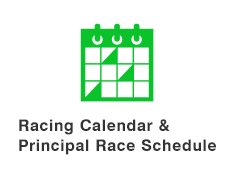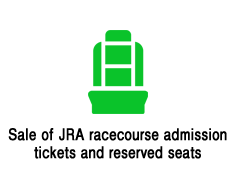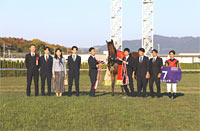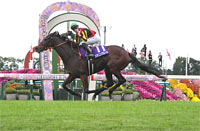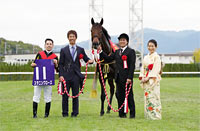2025 News
Queen Elizabeth II Cup (G1) - PreviewAfter a short breather in the JRA Grade 1 schedule last week, top-level racing in Japan returns this Sunday (November 16), and will continue for every weekend right up until the end of 2025. Kyoto Racecourse stages the Grade 1 Queen Elizabeth II Cup this week, which will be the 50th running of the race, named in honor of the late monarch and her visit to Japan in 1975. Such was her passion for horseracing, there are a number of races throughout the world named after her, and the link between the sport in Japan and England has undoubtedly grown over those intervening years. There are sure to be various displays and events marking Sunday’s milestone, with it becoming a popular Ladies’ Day in recent times. Kyoto Racecourse is also celebrating its 100th anniversary this year. Here’s a look and some of the fancied runners expected to play a part in the race: Regaleira: Last year’s Grade 1 Arima Kinen winner was a little disappointing in her first run this year, when she finished 11th in the Grade 1 Takarazuka Kinen in June. She bounced back to form last time, however, when winning the Grade 2 Sankei Sho All Comers at Nakayama in September. Assistant trainer Yu Ota said: “The jockey was confident last time and rode a good race. The horse’s action was a bit stiff, but there’s no mistaking her liking for the tight Nakayama course. It was great that she won the race again with Jockey Keita Tosaki. She’s returned to the stable from a break at the farm and seems very well in herself.” The key could be the Kyoto track, where she has run just once and finished fifth, that race being last year’s Grade 1 Queen Elizabeth II Cup. Erika Express: The 3-year-old filly by Epiphaneia came within a whisker of winning the Grade 1 Shuka Sho last time, when given a great front-running ride by jockey Yutaka Take. Erika Express has always been in the first two from her two starts at Kyoto, and Take takes the ride again to try and go one better this time. Trainer Haruki Sugiyama commented: “The Kyoto track seems to suit the horse, and if she hadn’t just got caught off guard a little in the backstraight last time, she may have produced a bit extra. She came out of the race well and her appetite’s good.” Japan’s legendary rider is looking for his 85th JRA Grade 1 victory. Stellenbosch: Although she’s had plenty of experience racing at Grade1 level (seven starts in all), her only top-level victory came in the 2024 Oka Sho (Japanese 1000 Guineas). Having said that, she’s gone close on a number of occasions, and trainer Sakae Kunieda hopes she can put her last run behind her, when she could only finish 15th of 16 in the Grade 2 Sapporo Kinen in August. “Despite her condition being quite good in the Sapporo Kinen, she didn’t respond so well at the end, and it seemed to be a mental thing with her,” the trainer said. “She had a break at the farm, and has returned to Miho, before transferring to the Ritto Training Center.” Paradis Reine: The 3-year-old filly by Kizuna never seems to run a bad race, and as well as finishing fourth in this year’s Grade 1 Yushun Himba (Japanese Oaks), she was last seen flashing home late to take third in the Grade 1 Shuka Sho at Kyoto in October. Comments from assistant training staff were: “She closed well in her last race, with the fastest final three-furlong time. Things have been as usual with her since, and looking at her run in the Oaks, the long homestraight on the outer course at Kyoto would seem to suit her.” Coconuts Brown: Despite being by Kitasan Black, Coconuts Brown is a lightly raced 5-year-old mare, whose highest-level runs have been at Grade 2 and Grade 3 level, but after her last run in the Grade 2 Sapporo Kinen in August, when she finished second, she certainly deserves to take her chance here. Trainer Hiroyuki Uemura has one of the best win strike rates among the top ten trainers, and he had the following to say about Coconuts Brown: “After her two races in Hokkaido this summer, she returned to Ritto early, and has had plenty of time to recover. Her appetite’s been better than usual, and she’s a mature horse now. I definitely think she has the potential to do well in a Grade 1.” Kana Tape: The Noriyuki Hori-trained Kana Tape is one of the oldest horses among the nominations, but the 6-year-old mare has been putting together some good results recently, with her latest being a third-place finish in the Grade 2 Ireland Trophy at Tokyo in October. The trainer said: “She’s been at the stable, recovering from her last race, and starting off her preparation for this next one, she’s done some work on the uphill, posting a good time. Damian Lane rode her on October 30, and the horse seems to be in very good shape. After that workout, she weighed 481kg.” Kana Tape has had a number of different jockeys, and this will be just the second time for Damian Lane to take the ride. Vermicelles: The 5-year-old daughter of Gold Ship is another tackling a Grade 1 for the first time, but her runs in Grade 2 and Grade 3 races this year have been reasonable, despite running over longer distances. In her latest race, she finished third at big odds in the Grade 2 Kyoto Daishoten over 2,400 meters in October. Trainer Keiji Yoshimura said: “The Kyoto Daishoten was a high-level Grade 2 race, and the going on the first weekend of the meeting was a little soft, so I wondered how she might do. The jockey did well by sticking to the inside throughout the race, and for a moment it looked as if the horse could win. Despite her wins at Kokura and Fukushima, the wider Kyoto track is a help for her.” Shinryokuka: The 5-year-old mare has certainly had a lot of graded race experience, with only two of her sixteen starts not being a graded race. She finished ninth and fourth in the Grade 1 Queen Elizabeth II Cup in 2023 and 2024 respectively, so she could be one at a price to spring a bit of a surprise, as is often the case. She was last seen finishing fourth in the Grade 3 Niigata Kinen in August. Trainer Masahiro Takeuchi commented: “She had to carry more weight than when she won the Niigata Kinen last year, and the flow of the race didn’t suit her, but, overall, it wasn’t a bad run. She’s had a break at the farm with this race in mind for her next.” |
|








